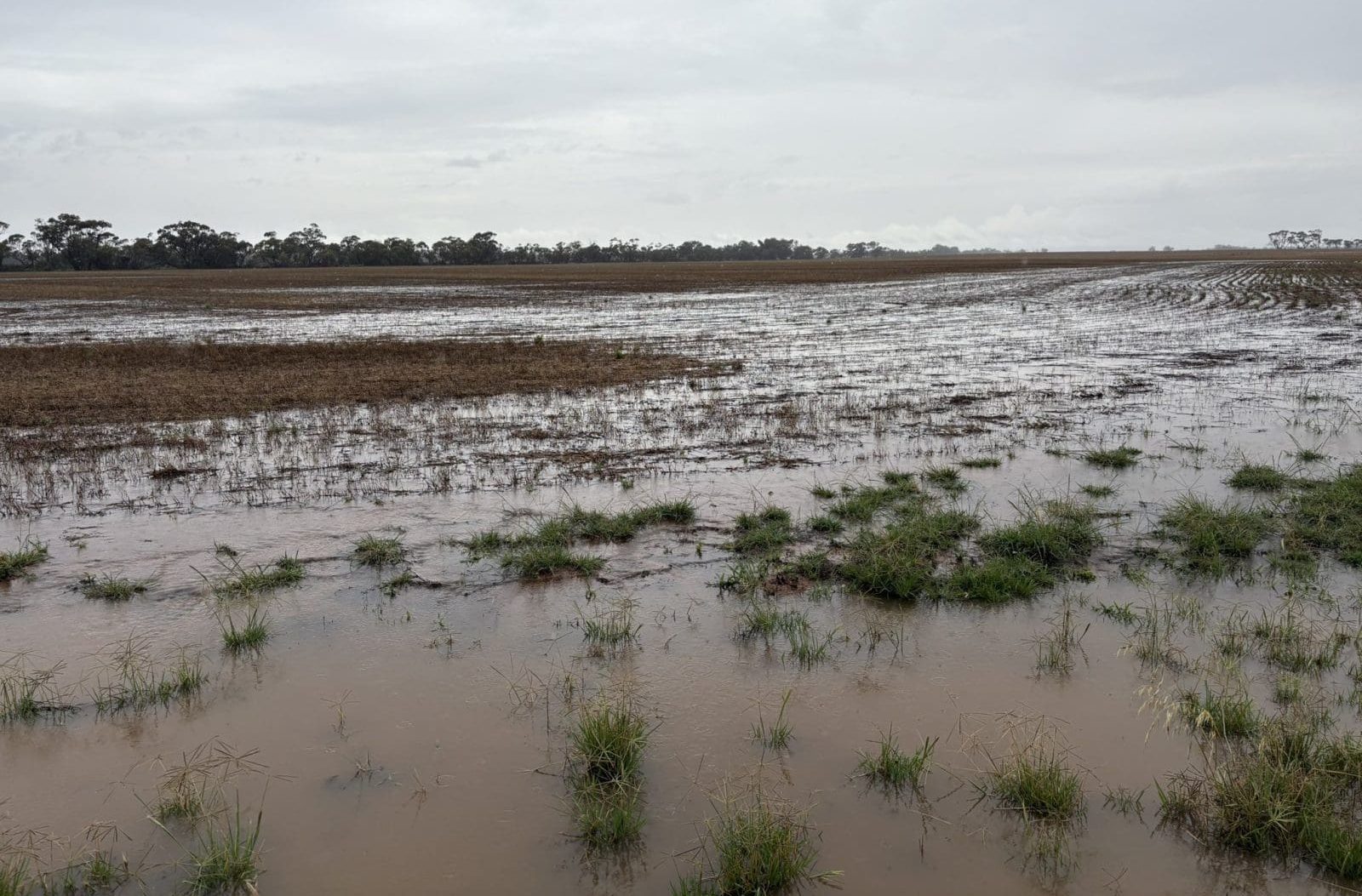
Plenty of rain has fallen in the past week in parts of the Mallee, where most crops apart from wheat have been harvested. Photo: Matt Witney, Dodgshun Medlin
VALUES for southern barley and ASW wheat have firmed following rain which has slowed harvest and grain deliveries, but brought to life an SFW wheat market which will satisfy some consumers’ needs.
In Queensland and northern New South Wales, harvest is all but over, and some growers are selling feed barley and lower-protein wheat as the start of the sorghum harvest nears.
The northern barley market has softened a little on grower selling, while ASW wheat has firmed as consumers face the prospect of unharvested wheat in Vic and southern and central NSW coming in with light testweights and some sprouting.
| Prompt | Nov 28 | Jan fwd | Nov 28 | |
| Barley Downs | $318 | $320 | $320 | $323 |
| ASW Downs | $342 | $340 | $355 | $340 |
| Sorghum Downs | $320 | $340 | $315 Mar | $323 |
| Barley Melbourne | $335 | $330 | $330 | $325 |
| ASW Melbourne | $360 | $355 | $355 | $355 |
Table 1: Indicative prices in Australian dollars per tonne.
Sellers come forward in north
Grower interest in selling wheat and barley has picked up in the past week now most have finished harvest, and have largely or fully completed their chickpea selling programs.
While plenty of chickpeas are still on farm ahead of their journey to Brisbane for export, traders say growers now have the time to think about pricing some barley or wheat into the feedgrain market.
“The Downs market for feed is $3-$4 softer than it was at the start of last week, and you can pick up wheat for July-August at $355, which is below the cost of carry,” one trader said.
“There’s definitely a bit more grower selling this week; guys want to sell some cereals and make some rain for sorghum.”
Rain in central and southern NSW and into Vic has made growers in the north with high-quality wheat left to sell hopeful of further rallies for APW and above segregations as falling numbers machines are deployed at receival sites across NSW and Vic.
“Any protein booked to go out of Victoria and Port Kembla could be hard to get.”
Meanwhile, northern consumers are looking as far south as central NSW for some rain-affected grain to blend with high-spec loads available locally.
Patchy rain of 20-40mm in places has fallen in southern Qld, where sorghum crops are generally looking at above-average yield potential, and good rain has also fallen in parts of Central Qld ahead of sorghum planting in January-February.
In grain-growing regions, Mungindi on the Qld-NSW border had the highest fall in the week to 9am today of 171mm.
Other Qld registrations include: Clermont 77mm; Emerald 23mm; Jondaryan 20mm; Roma 15mm; Springsure 13mm, and Surat 93mm.
Southern
More rain in the week to today has further challenged quality prospects for wheat in Vic and southern NSW.
While at least three-quarters of Vic and southern NSW barley paddocks have been harvested, a large chunk of the wheat crop is still standing, and looking highly unlikely to grade APW or better if it got more than 20mm of rain in the past fortnight.
A number of localities in the Mallee in particular did dodge the rain, but weather has been humid and far from ideal for grain ripening and harvest.
Rainfall registrations in the week to 9am today include: Berriwillock 40mm; Birchip 17mm; Dunolly 38mm; Horsham 32mm; Nhill 5mm; Ouyen 20mm, and St Arnaud 24mm.
In central and southern NSW, rain was generally heavier, but over more isolated areas, and falls included: Ardlethan 77mm; Barellan 45mm; Condobolin 139mm; Forbes 102mm; Manildra 84mm; Urana 27mm; West Wyalong 105mm, and Young 123mm.
Ahead of more rain forecast for tomorrow and Saturday, Wilken Grain trader Andrew Kelso said growers whose harvest was interrupted by rain were expected to get going again yesterday or today
A low-rainfall growing season for Vic and southern NSW means wheat already in the bin is mostly of above-average protein and good quality, enough to amply cover domestic flour-milling requirements, plus some for export.
It is the stockfeed wheat, or SFW, market that has sprung this week, and represents good buying for those looking for loads to blend with higher-spec wheat.
“There’s an SFW market now that wasn’t there before, and…the stockfeeders should be happy about that,” Mr Kelso said.
The SFW market is consolidating at up to $15-$20/t below ASW, and prompt markets generally are $5-$10/t above the January forward markets as rain this and last week, and more on the forecast, makes it tricky for some consumers to access spot loads.
For some growers, rain has created a clear divide between pre-rain high-spec wheat to sit on, and weather-damaged grain to look at selling now.
“People are now pricing SFW instead of APW and H2, and SFW is $10-$15 under ASW,” one up-country trader said.
Those on-farm values are sitting at around $290-$310/t for ASW, with SFW at more like $270-$280/t.
ENDS

HAVE YOUR SAY